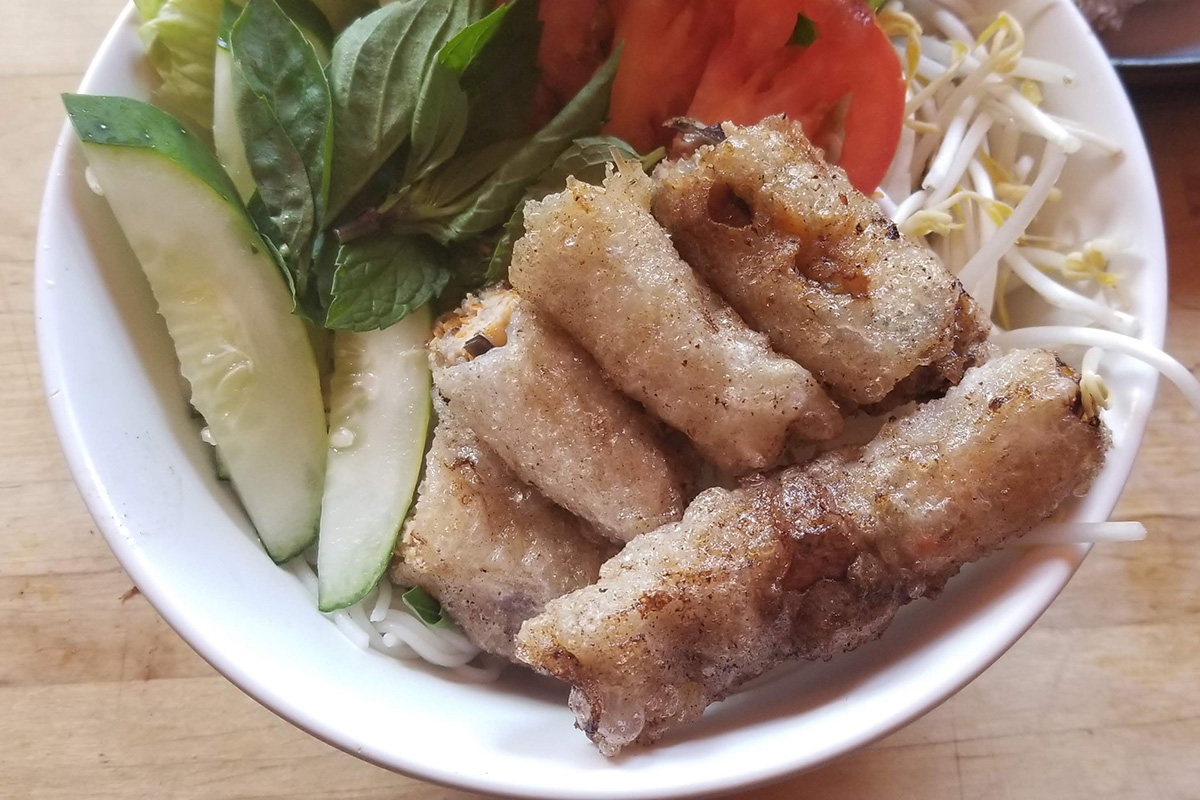Recipe: Chả Giò, More than the “Vietnamese Spring Roll”

Photo by Kathy Phung
It would be easy to call chả giò (pronounced cha yaw) Vietnamese spring rolls and leave it at that. But the story doesn’t start nor end there.
At the 1979 Folklife Festival, we featured guest chef Phan Hoang, of Bowie, Maryland, who shared her Vietnamese cuisine as part of the Folklore in Your Community program. Her chả giò was a mixture of ground pork, shredded carrots, minced onion, bean threads, and wood ear mushrooms, wrapped in moistened rice paper, then deep fried.
As with regional adaptations, some Vietnamese chả giò makers switched from using rice papers to squares of wheat wrappers that make the ubiquitous spring rolls normally found in Chinese cuisine. With wheat wrappers, the extra task of moistening the rice papers and subsequent drying is gone, and a more even, golden brown can be achieved during frying. Between using a spring roll wrapper, and the previous existence of spring rolls in American nomenclature and cultural knowledge, it’s understandable why chả giò could also be called “Vietnamese spring rolls” here in the United States.
But is chả giò made with wheat wrappers still chả giò? Can a Chinese spring roll be chả giò? Is a Philly cheesesteak egg roll anything but an abomination? Cookbook author Andrea Nguyen provides her own take on her mother’s chả giò recipe in Into the Vietnamese Kitchen: “Their filling, wrapper, and accompaniments are uniquely Vietnamese. Out of culinary pride, I encourage people to call these rolls chả giò, their southern Viet name… Some Vietnamese American cooks use Filipino lumpia or Chinese spring roll wrappers… but an authentic flavor is lost. For the best results, use rice paper made of all rice flour or of rice and tapioca flours.”
This was my first time making chả giò with rice paper, so I read up on some frying tips. I suggest taking extra care when soaking the rice paper; a quick dip and then a good shake is all that is needed. The paper may still seem unpliable when you begin rolling, but if you wait just a touch longer, the paper softens up quickly. Not only does rice paper have a tendency to blister up, it doesn’t brown very well either, leading to possible over-frying and becoming excessively oily. However, it does in fact taste very different from my normal spring roll wrappers, and it’s a bonus that rice paper is shelf stable.

Chả giò
Recipe by Phan Hoang
Bowie, Maryland
Ingredients
2 pounds ground fresh pork butt (half crab meat or fresh shrimp optional), finely chopped
2 tablespoons nuoc mam (Vietnamese fish sauce)
1 teaspoon salt
1/2 teaspoon white pepper
1 large egg
1/2 pound onions (or green and white onions), finely chopped
1/2 pound carrots, finely chopped or grated
1 bunch (2 ounces) bean thread (or Chinese vermicelli, softened in water, drained, and cut into 3-inch lengths)
1/2 ounce Chinese dried fungus (or Chinese mushrooms, soften in water, cleaned, drained, and sliced)
1 teaspoon sugar
2 cups water
Rice paper
Corn oil, for frying
Lettuce, for garnish
Fresh mint, for garnish
Sauce
1/2 cup nuoc mam
1/2 cup water
1/4 cup white vinegar
1 clove garlic, pounded
2 tablespoons sugar
1 small red hot pepper, crushed (optional)



Preparation
Mix meat, or meat and fish mixture, with seasonings and egg. Cover and refrigerate.
Chop onions, carrots, bean thread, and Chinese fungus. Mix with meat.
To moisten rice papers (one at a time), stir sugar into water and pour into a large plate. Dip whole rice paper into water, then quickly remove; drain excess water. Place paper flat on a large cutting board.
Put one heaping tablespoon of meat mixture on rice paper. Begin to roll gently; when half rolled, tuck both sides in, and then continue to roll up. When several rolls are made, put them on a rack in the refrigerator to let the rice paper dry.
To fry rolls, preheat oil in a frying pan on medium heat. There should be enough oil for the rolls to float to the top without touching the bottom of the pan. When oil is hot enough, put in fresh rolls. Allow meat to cook well, for about three to five minutes.

Kathy Phung is the foodways coordinator for the Smithsonian Folklife Festival, who also manages the demonstration kitchen at the National Museum of American History. Armed with a degree in anthropology and baking and pastry arts, she has worked in various food enterprises in the D.C. area as an oompa loompa, pastry cook, and butcher.

